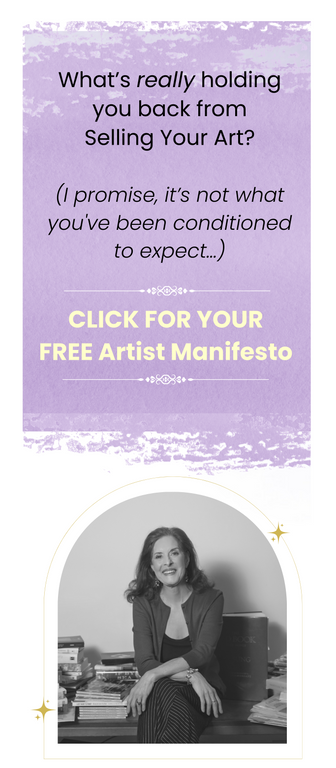Where Studio Time Plays The Central Role In “Your Art Is Visible”
First, let’s do a quick review of the last blog post Selling-Your-Art: Building Block No.2, Your Art Is Visible (Part 1.) where we looked at a process called “Map The Gap.” And how this keeps the dynamic connection between your art’s visibility and selling your art alive and strong.
Map The Gap: Let’s review
There are a number of ways your art can become unintentionally more invisible than visible.
- When you’re faced with an art sale falling apart.
- Or a time when you want to put your art in the world, but you hit roadblocks with other people who are involved.
- Or you have a difficult commission client who presses all your buttons.
- You’re struggling with a collector, buyer, gallery owner, or another artist
In any of these scenarios, Map the Gap is a sleek and easy process to identify, and eliminate, one internal factor that can gum up selling your art.
When you Map the Gap, you can adjust your behavior to accurately reflect your sincere intention. This comes in handy when you need to navigate any sticky relationship affecting you selling your art.
In five easy steps, Map The Gap often untangles the knot.
But how?
Since most of us, most of the time, think and feel that our internal experience automatically aligns with our external behavior, we fail to check it out.
But if we recognize this dissonance (the gap), and if we Map the Gap, suddenly there’s a release in any tangled knot of circumstances for us to:
- a) Recognize that our behavior is not honoring our intention accurately
- b) Address the gap with the person involved
- c) Mindfully create behavior that reflects the truth of your intentions
- d) Align, with integrity, with whomever is interacting with us
All of which leads to the potential for selling your art with grace and ease.
Now, let’s tackle the next visibility/invisibility factor that might be affecting when you are selling your art: Studio Time.

Is Studio Time Undermining The Visibility You Need For Selling Your Art?
When other demands come into play, studio time often gets no play time. Or at least, not as much as your creative spirit needs and wants. Which often means, after taking care of the “others” in our lives, we end up with crumbs.
But the truth is that studio time is the one external, visibility factor guaranteed to affect selling your art.
Then, there’s the “putting ourselves first” to deal with. We harbor a cultural mandate that declares nurturing and caring for others as an altruistic character trait, and caring for ourselves as selfish.
If we ignore this mandate, we run the risk of being labeled “selfish,” a form of social shunning that exacts a black mark against our reputation as a good person.
Unfortunately, other traits, like self-centered, get thrown into the same roiling pot.
In truth, there’s an unacknowledged irony here.
Being selfish, where someone behaves only in their own interest with no concern for others, most often rises out of that person’s inability to discern what their real needs are. So their Alert Protective Self works very hard to grab their attention… to pay attention to what they truly need.
This hyperfocus—or self-centered focus on essential inner needs that are not being addressed—means the person’s inner attention is totally absorbed in an effort to wake up the part of themselves that is sleepwalking.
This isn’t selfishness as a disservice to others, but as a disservice to oneself.
If you, in an effort to make studio time a priority so selling your art becomes a reality, experience either yourself, or anyone around you, labeling you as “selfish,” or “self-centered” …
Pause, breath, and take a moment to examine which kind of selfishness is actually operating.
Do you truly need to focus on taking care of what you need? And, so, for a time this means you don’t have the bandwidth to also be a caretaker/cheerleader/nurturer for others?

Finding more time to create, so selling your art becomes viable, is what haunts most artists I’ve worked with.
And oddly enough, even the most productive artists, who seem to easily overcome roadblocks, they also tell me they feel as if they can’t carve out enough studio time to make the art they need for selling their art.
Which makes me to wonder if time is the culprit, or merely an easy rationale masking other issues.
Often Time Slips Away Because We Aren’t Paying Attention To It
When you want to change behavior that operates on autopilot, try this:
- Name, or better yet, write down the specific roadblock, or roadblocks, that take away from your studio time.
When we name something directly, it directs our brain to retrieve it from our sub/unconscious to make it consciously available so we can work with it.

- Brainstorm options for what you, or those around you, can do to reduce the amount of time you spend on this roadblock. With classic brainstorming, you need to get all the “obvious” options out of the way first before the creative ones come up. So get every idea down on paper, without editing or judging.
- Keep in mind that we operate on a limited amount of will per day. Every decision, or action we take, eats up a portion of our will. If studio time is paramount (and I’m hoping it is), do that before you do anything else. This is the best way I know to maximize any amount of time you have for a project, especially if it has to be limited
- Write a mantra for your studio time. Print it out. Or paint it out…and put it where you can see it every day.
Here is a list of the most common Studio Time Thieves stealing the very art you need to sell your art:
Work/Income Conflicts:
- Where you have to balance making art with a day job (or two, or three…)
Responsibility for Caregiving:
- When children, elderly parents, or other members of your family need you
Issues With Your Health:
- When physical or mental health issues limit your energy and focus
Household Responsibilities and/or Distractions:
- When daily life chores and demands nibble away at your studio time
- Where frequent interruptions or distractions break your creative focus
- When you don’t have a dedicated, separate studio space to remove you from home life
Motivational Factors:
- When you struggle with procrastination, lack of motivation, or creative blocks
- When you feel guilty dedicating so much time to your studio
- When you have an inspiration drought or burnout from life on steroids
Time Management:
- Where your administrative, art related tasks (exhibitions, teaching, marketing, etc.) interfere with your creative focus
- When you over commit to projects with deadlines that collide
- Faltering when it comes to a consistent studio schedule
Logistical Issues:
- When you need to travel regularly, so keeping a routine feels impossible

Here are three different perspectives on finding studio time that I’ve lifted straight out of the smARTist Telesummit Revival Podcast #2.
- Organizing as a foundational factor in studio time
- Defining your artistic direction with concrete specifics
- Understanding how both artificial and natural time impacts how we create
ORGANIZATION
- Jennifer Loudon (our smARTist Organizing Expert) starts with reminding us how we take ourselves to task for not having enough time in the studio, which undermines our creative mood.
With simple exercises, she helps artists find a way to be okay, in this moment, just as we are. Embracing the radical choice to truly believe there is nothing to change or fix, solve or get rid of.
Because, once you breath in that choice (and Jennifer knows exactly how to guide you toward this awareness), you open up to new moods and new choices that paradoxically, and gratefully, lead to finding more creative time in the studio—no matter what.
ARTISTIC DIRECTION
2. Aletta de Wal, M. Ed (our smARTist Art Career Expert) comes from a more traditional stance where you unleash the forces of desire, will and planning to the studio time you need and want.
Two of the building blocks affecting studio time that she explores are 1) how you define your artistic direction and 2) how you approach organization.
In her presentation, Aletta has you answer specific question to help you identify where you are right now, and what you need to go forward.
WHAT’S TIME GOT TO DO WITH IT?
3. Waverly Fitzgerald (smARTistâ Time Expert) offers a radical view of time in two distinct realms of experience: natural time and artificial time, and how understanding time in both realms impacts the personal, natural rhythms of our life.
As a creative herself, she shows us how to identify our sweet spot for creating, how to use the seasons to trigger a surge in creativity, how to find our “prime time” so we’re ready to work when we’re most creative, and why the ultradian rhythm works so well.
But, for me, the most influential part of Waverly’s presentation is her distinction between goal setting and theme setting and how she uses both of these, in tandem, to orchestrate time within her own life.
Here then are three, immediate tools you can use to get more studio time.
- Embracing your inherent, human wholeness as you organize and manage your studio time so selling your art becomes viable
- Paying attention to your artistic direction so selling your art becomes part of the artistic vision
- Learning how natural and artificial time impacts you on a daily basis so you are selling your art as a whole artist
Now, it’s your turn. When did you last experience the feeling that your time in the studio was “selfish?”
I’d love to start a conversation, so please leave me a comment.








